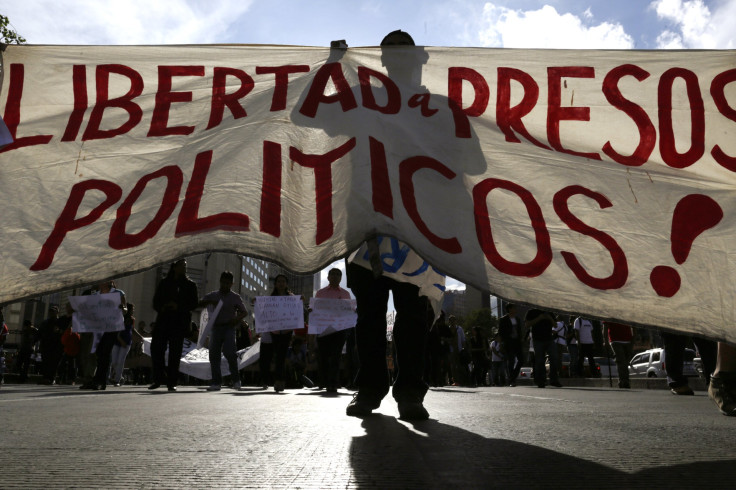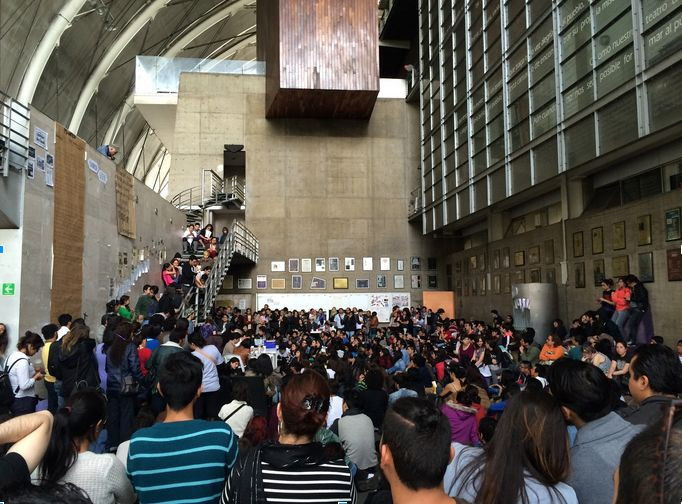Mexico City Gears Up For Mass Protest On Tuesday As Students Demand Release Of 11 ‘Political Prisoners’

MEXICO CITY -- Students and activists plan to take to the streets again Tuesday, marching down the main thoroughfare of Mexico's capital to the doors of the presidential palace, in a protest that could heighten the civil unrest that has been building since the disappearance of 43 students nearly two months ago.
"We're fed up. This country has suffered so many problems, so many incidents," Ulises, a 24-year-old university student, who didn't give his last name, said at an organizing meeting Monday.
Protesters are demanding the release of 11 people who were detained last week during a mass demonstration and charged with terrorism and mutiny.
The arrests are compounding the frustration that many Mexicans feel over what they say is a corrupt political system and repressive police force. The disapperance of the 43 students, believed to have been murdered by a criminal gang in cahoots with police because they opposed a local politician, precipitated the unrest.
The protesters are accusing the federal government of arbitrarily arresting eight men and three women last Thursday. The 11 are being held in maximum-security facilities, and they also face charges of homicidal intent and organized crime. Terrorism charges were later dropped. National human rights groups say the charges are severely overblown and claim that prosecutors have denied the arrested proper legal defense.
"There is no way to justify these grave crimes," Fernando Ríos, who heads human rights network La Red TDT, said. He criticized state and federal police for using "excessive force" and "acts of repression" against a mostly peaceful crowd.
Mexico’s Attorney General’s office maintains that the individuals, including a Chilean citizen, are responsible for the crimes and disturbances at the Thursday protest.
At last week's event, tens of thousands of people streamed into Zócalo square, a colonial construction surrounded by the president's ceremonial residence and the ornate Metropolitan Cathedral. Demonstrators called for presidential action to find the students, a largely symbolic demand now that the 43 are believed to have been killed and their bodies burned. Some people held signs calling for President Enrique Peña Nieto's ouster -- a few even burned effigies -- and accused the leader of turning a blind eye to the tragedy.
On the edge of the crowd, a group of about 100 young masked protesters began launching rocks, sticks, bottles of water and, eventually, Molotov cocktails at the presidential palace. When the violent group dispersed into the throngs of people, the police began attacking, according to interviews with people who were at the demonstration. Photographers with the Associated Press and the magazine Proceso reported injuries and images from that night show bloody faces and limping protesters.
"Police officers are there to contain people -- not repress them," Maria Elena Morera, president of citizen group Causa en Común, told reporters Monday. According to a study by the group, Mexico's state police departments are, on the whole, doing little to train and educate their officers or punish those who commit infractions. "We need to prepare our police better, so they know how to properly contain demonstrations," Morera said.
In the days after Thursday's march, friends and family of the prisoners led smaller protests, including a demonstration on Sunday down the main Reforma Avenue. A new slogan and Twitter hashtag was born: #LibertadPresosPoliticos, or Freedom for Political Prisoners. (Another slogan, #20NovMx, is also used to refer to last week's incident. #YaMeCansé, or "I'm fed up," is also popular.)

Tuesday's event, however, is expected to draw another large crowd as anger over the arrests and violence brews. The protest is expected to begin in the early evening of Tuesday.
At the National Center for the Arts, a public institution in Mexico City's south, roughly a hundred students and professors gathered in an open-air amphitheater Monday to discuss the upcoming protest. The purpose of the assembly wasn't to draw up plans of attack, but rather to figure out how marchers could protect themselves from the police. Atzin Andrade González, who attends the center's painting and sculpture school, is among the group of 11 detainees.
"It's actually kind of scary," Eduardo, a 23-year-old student at the center's music school, said. "But we can't give in to that fear. Even though we know [the police] have the power to disappear us, we have to continue so they don't do it to anyone else."
Marcha mañana, 4pm. #LibertadPresosPoliticos #YaMeCansé pic.twitter.com/JVE5mowxeP
- Sara Pinet (@sarapinet) November 24, 2014© Copyright IBTimes 2025. All rights reserved.





















